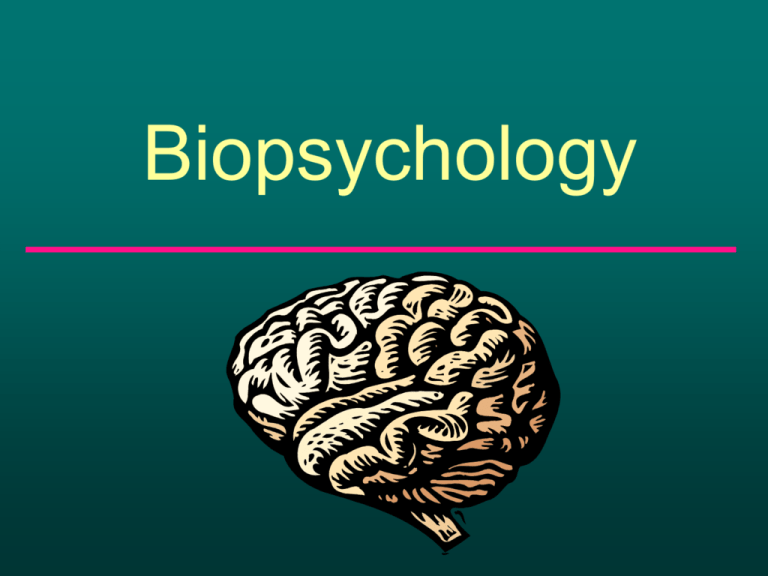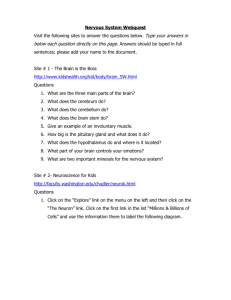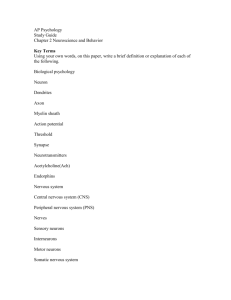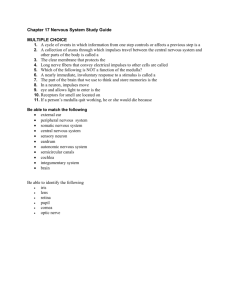Biopsychology revision 2
advertisement

Biopsychology What makes you, you? What makes you unique from every other person? The Mind is what the Brain does • Specific areas of the brain and specific systems in the body are responsible for – – – – – – – – Learning and Memory Sensing and perceiving Emotion Personality Planning Attention and arousal Motivation Etc. The building blocks of the brain The Neuron The Neuron • Types of Neurons – Sensory neurons (carry messages from sense receptors towards the CNS) – Motor neurons (carry messages from CNS toward muscles and glands) – Interneurons (carry messages between nerve cells) The Structure of a Neuron Neural Communication • Two states – Resting Potential Negatively charged ions on inside; positively charged ions on outside; cell is negatively charged on inside relative to outside – Action Potential Based on summation of excitatory and inhibitory signals Cell depolarizes; i.e., cell becomes positively charged Voltage change (electrical surge) travels down axon and causes release of neurotransmitter into the synapse Neural Communication • All or None Law – Neurons either fire or they don’t – Require a minimum amount of excitation or stimulation in order to fire – Once the minimum threshold has been reached, the neuron will fire – Regardless of the intensity of stimulation, the neuron will fire with the same intensity Neural Communication • If neurons always fire with the same intensity, how do we discriminate intensity of the stimulus? – The # of neurons stimulated by a single stimulus – Rate of firing (up to a maximum) Neural Communication • Once the neuron fires, it releases its Neurotransmitter into the synapse – Neurotransmitter Chemical messengers that relay neural messages across the synapse • Neurotransmitter fits in receptor like a key fits in a lock • Neurotransmitter either excites or inhibits the post-synaptic cell by binding to its receptors Neuron Demonstration Neural Communication • Methods to stop neural transmission – Reuptake – Degradation – Presynaptic autoreceptors Seven Important Neurotransmitters Dopamine Serotonin Norepinephrine Acetylcholine GABA Glutamine Endorphins Normal Function: Dopamine Serotonin Norepinephrine Produces sensations of pleasure and reward; used by CNS neurons in voluntary movement Problems with Imbalance: Acetylcholine GABA Glutamine Endorphins Schizophrenia, Parkinson’s disease Substances that Affect: Cocaine, amphetamines, Ritalin, alcohol Normal Function: Dopamine Serotonin Regulates sleep and dreaming, mood, pain, aggression, appetite and sexual behavior Norepinephrine Problems with Imbalance: Acetylcholine GABA Depression, certain anxiety disorders, obsessivecompulsive disorder Glutamine Substances that Affect: Endorphins Prozac, hallucinogenics (e.g. LSD) Normal Function: Dopamine Serotonin Norepinephrine Controls heart rate, sleep, sexual responsiveness, stress, vigilance and appetite Problems with Imbalance: Acetylcholine GABA Glutamine Endorphins High blood pressure, depression Substances that Affect: Tricyclic antidepressants, beta blockers Dopamine Normal Function: Serotonin Pleasurable sensations and control of pain Norepinephrine Problems with Imbalance: Acetylcholine Lowered levels resulting from opiate addiction GABA Glutamine Endorphins Substances that Affect: Opiates: opium, heroin, morphine, methadone Plasticity • Plasticity – – Ability of the nervous system to adapt or change as the result of experience; sometimes helps the nervous system adapt to physical damage The Organization of the Nervous System Nervous system Peripheral nervous system Autonomic nervous system Sympathetic nervous system Central nervous system (CNS) Somatic nervous system Parasympathetic nervous system Divisions of the Nervous System • Central Nervous System (CNS) – Brain and spinal cord • Peripheral Nervous System (PNS) – Connects brain and spinal cord with the rest of the body Peripheral Nervous System • Somatic Nervous System – Carries incoming messages from sense organs – Carries outgoing messages to skeletal muscles; mobilizes voluntary movements • Autonomic Nervous System – Carries signals from the CNS to the internal organs – regulates involuntary functions such as digestion, respiration, heart rate Autonomic Nervous System • Sympathetic Division – Mobilized under stress – (e.g., controls 4 F’s) • Increases heart rate and respiration, increases muscle tension, shuts off digestion • Parasympathetic Division – Responsible for basic processes or homeostasis • Slows heart rate and respiration, increases digestive functioning Example • Hear rattlesnake – Somatic NS orients eyes to sound to locate snake – Sympathetic Division of ANS mobilizes fight or flight response (i.e., blood to skeletal muscles; increases respiration) – Somatic NS initiates skeletal muscles to escape – Once escaped, Parasympathetic NS initiates relaxation response The Endocrine System (the body’s chemical messenger system) The Endocrine System • Pituitary gland – Master gland; i.e., produces hormones that influence the secretions of all other endocrine glands – Attached to and controlled by hypothalamus The Endocrine System • Endocrine glands release hormones into bloodstream; circulate through body until target organ is reached • Non-stress conditions supports parasympathetic nervous system in maintaining basic processes or homeostasis • Stress conditions supports sympathetic nervous system through release of epinephrine (adrenaline) Example Revisited • Hear rattlesnake – Somatic NS orients eyes to sound – Sympathetic Division of ANS mobilizes fight or flight response – Somatic NS initiates skeletal muscles to escape – Parasympathetic NS initiates return to resting state, But, … – Endocrine system release of adrenaline, explains why you feel edgy for a long time afterward The Endocrine System Glands Systems/ Processes regulated Anterior Pituitary Ovaries and Testes, Milk production, metabolism, stress reactions Posterior Pituitary Conservation of water, milk secretion, uterus contractions Thyroid Metabolism, physical growth & development Parathyroid Calcium levels Pancreas Glucose (sugar) metabolism Adrenal glands Fight or flight response, metabolism, sexual desire (especially women) Ovaries Female sex characs., production of eggs Testes Male sex characs., sperm production, sexual desire How Does the Brain Produce Behavior and Mental Processes? The brain is composed of many specialized modules that work together to create mind and behavior Film on Structures of the Brain Three Layers of the Brain • Brain stem and cerebellum – Drive vital functions, such as heart rate, breathing, digestion • Limbic system – Adds emotions, complex motives, increased memory abilities • Cerebrum – Enables reasoning, planning, creating, problem solving The Brain Stem and Cerebellum • • • • • Thalamus Pons Cerebellum Medulla Brain stem The Limbic System • Hypothalamus – Serves as the brain’s bloodtesting laboratory, constantly monitors blood to determine the condition of the body The Limbic System • Amygdala – Involved in memory and emotion, particularly fear and aggression The Limbic System • Hippocampus – Involved in establishing long-term memories The Cerebrum • Cerebrum – Topmost layer of the brain; the bulbous cap over the limbic system • Cerebral cortex – Thin gray-matter covering of the cerebrum; carries on thinking and perceiving • Cerebral hemispheres – The two walnut shaped halves of the cerebrum, connected by the corpus callosum Phineas Gage Specialization of the Cerebral Hemispheres Left Hemisphere Right Hemisphere • Spontaneous speaking and writing • Responses to complex commands • Word recognition • Memory for words and numbers • Sequences of movements • Feelings of anxiety • Positive emotion • Repetitive but not spontaneous speaking • Responses to simple commands • Facial recognition • Memory for shapes and music • Spatial interpretation • Emotional responsiveness • Negative emotion Film on Split-Brain








